Iterated integrals & partial integration [11.2]

We saw that the double integral:
$$\iint_R f(x,y)\,dA$$
represents the volume between the rectangle $R\equiv[a,b]\times[c,d]$ (in the $x,y$ plane) and the surface $z=f(x,y)$ above $R$.
Now we'll see how to evaluate such an integral.
Partial Integration
How to evaluate a double integral like $$\iint_R f(x,y)\,dA=\iint_R f(x,y)\,dx\,dy?$$
We'll do this in pieces, or to be more precise, in slices!

Marco Verch
We define...
Partial integration of a function $f(x,y)$ with respect to $y$ using this notation: $$\int_{y=c}^d f(x,y)\,dy=A(x).$$ This means A(x) is the result of
- Treating $x$ as a constant,
- carrying out the integration with respect to $y$.
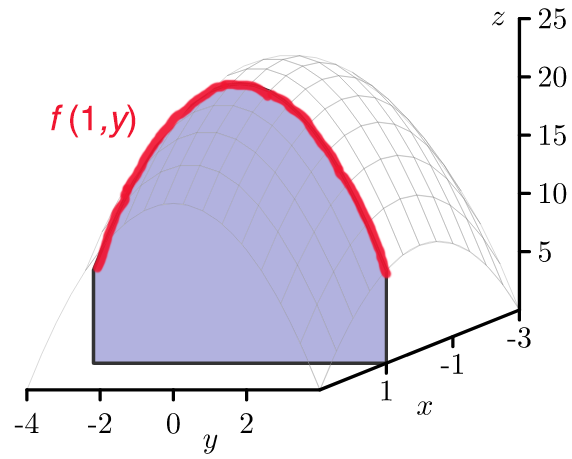 Holding $x=1$, and integrating the trace $f(1,y)$ gives us the area of the cross-section shown, $A(x=1)$.
Holding $x=1$, and integrating the trace $f(1,y)$ gives us the area of the cross-section shown, $A(x=1)$.
We write it as $\color{#8098d9}A({\color{green}x})$ because:
- It is the area of a slice resulting from the (partial) integration w.r.t. $y$,
- That area varies depending on the value of $\color{green}x$ of the slice.
example: $f(x,y)=2-x-y$, $$\begineq\int_0^1 (2-x-y)\,dy&=\int_0^1 (2-x)\,dy-\int_0^1 y\,dy\\ &=(2-x)\int_0^1 dy-\int_0^1 y\,dy\\ &=(2-x)\,\left. y \right|_0^1-\left.\frac12 y^2\right|_0^1\\ &=(2-x)(1-0)-\frac12(1^2-0^2)\\ &=2-x-\frac12\\ A(x)&=\frac32-x. \endeq $$
Double integral
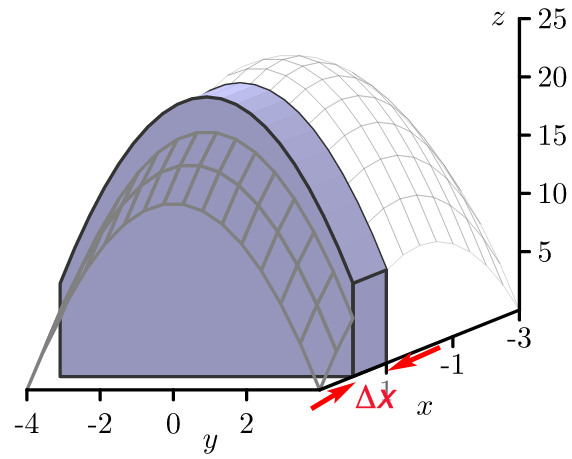 Multiplying the cross-section area by a width $\Delta x$, gives us a "bread slice" with a volume of $A\Delta x$.
Multiplying the cross-section area by a width $\Delta x$, gives us a "bread slice" with a volume of $A\Delta x$.
 And adding up the volumes of slices at different $x_i^*$ values can give us an approximation to the volume under the surface.
$$V\approx\sum_i A(x_i^*)\Delta x$$
And adding up the volumes of slices at different $x_i^*$ values can give us an approximation to the volume under the surface.
$$V\approx\sum_i A(x_i^*)\Delta x$$
If we make the slices vanishingly thin $$\sum_i A(x_i^*)\Delta x\to\int A(x)\,dx.$$
Carrying out the integration of $A(x)$ with respect to $x$... $$\begineq \int_{x=a}^b \color{blue}{A(x)}\,dx&= \int_{x=a}^b \left(\color{blue}{\int_{y=c}^d f(x,y)\,dy} \right)\,dx\\ &=\int_{x=a}^b \int_{y=c}^d f(x,y)\,dy \,dx\\ \endeq $$ ...results in a double integral equal to the volume under the surface above the region $R$.
This rather sloppy way of writing the double integral leaves it unclear whether you should evaluate the partial integral of $y$ first, and then integrate over $x$, or vice versa. Perhaps it doesn't matter?
Fubini's Theorem
...says that for a rectangular region $R$ and some pretty general assumptions, the order of partial integration does not matter.
Example 1
Find the volume underneath $f(x,y)=2-x-y$ and above the rectangle defined by points in the $x$-$y$-plane: $0\lt x \lt 1$, and $0\lt y\lt 1$. (Alternately, $R=[0,1]\times[0,1]$.)
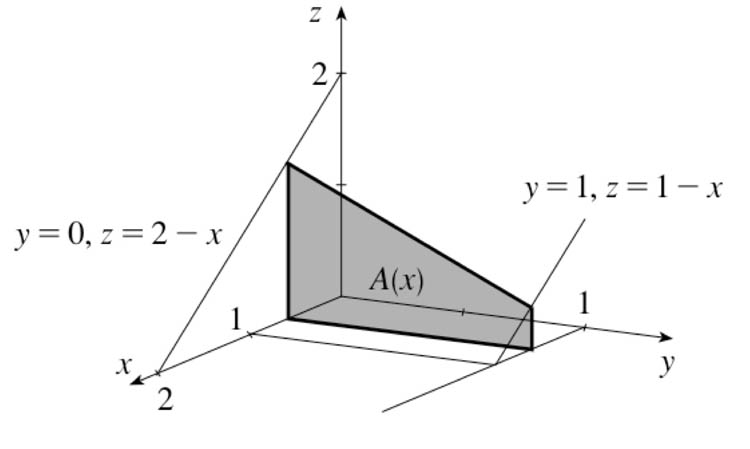
$$ \begineq V= \iint (2-x-y)\,dA &= \int_{x=0}^1\int_{y=0}^1(2-x-y) dy dx
\\&= \int_{x=0}^1\left(\int_{y=0}^1 (2-x-y)\,dy\right) dx
\endeq$$
We already carried out the partial integral in $(...)$. Substituting the result back into the expression for $V$, $$ \begineq V&=\int_{x=0}^1\left(\frac 32 - x\right)\,dx = \frac 32\int_0^1 dx -\int_0^1x\,dx\\ &=\frac32-\frac12=1 \endeq $$
Example 2
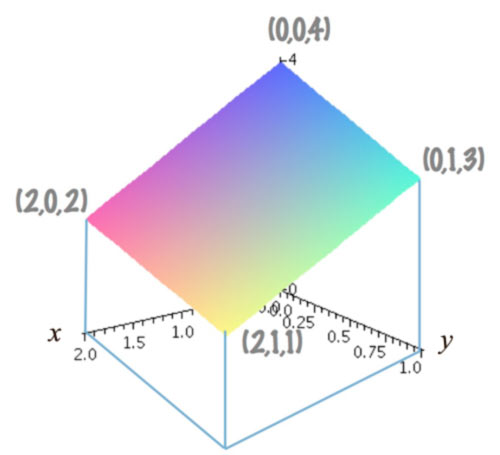
The function for the surface is
$f(x,y)=4-x-y$.
- Estimate the volume under this surface, for example, by estimating the average height of the surface, then multiplying by the area of the rectangle $R$ underneath.
- Evaluate the double integral to find the exact volume.
- Evaluate the integral over $dy$ first, treating $x$ as a constant.
- This results in $A(x)$.
- Evaluate the integral of $A(x)$ over $dx$.
How to do this in CoCalc:
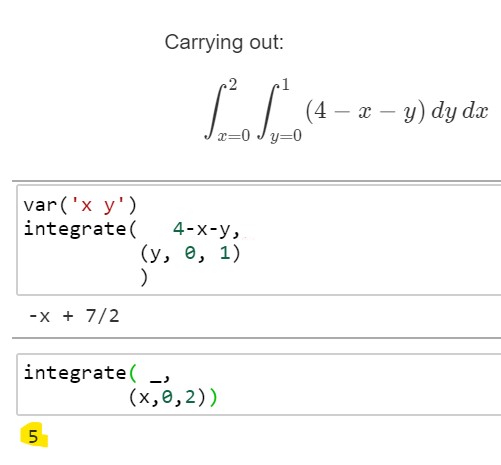
How to do this in Mathematica.
To Do
- 11.2.practice: Double integrals - practice: #1-4
- 11.2.shape: The shape of the solid